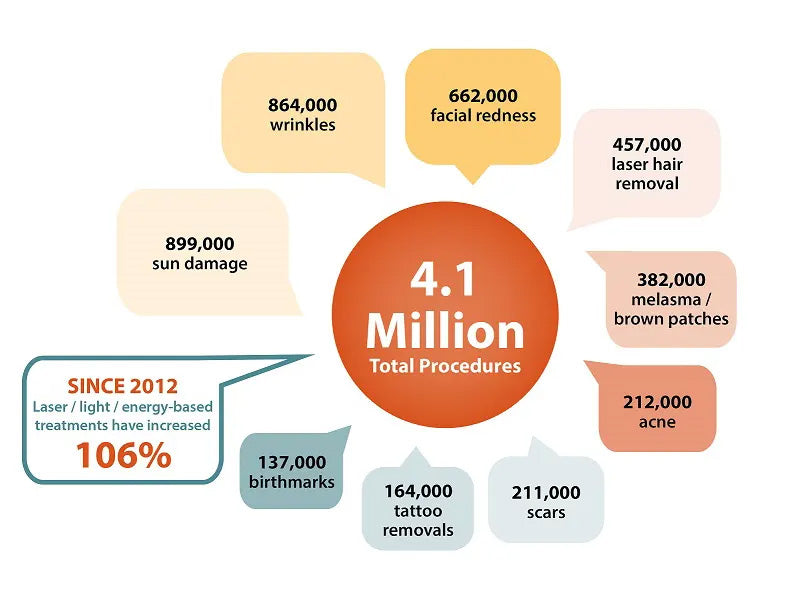Laser Hair Removal VS. Electrolysis
Removing unwanted hair is a hassle. Both laser hair removal and electrolysis reduce hair growth in long-term. They both target and destroy hair follicles beneath the skin. So you can use them on legs, the face, pubic region – almost anywhere.

Laser now is the most popular hair removal option. The number of laser procedures have increased 106% since 2012, according to an ASDS survey.
"Laser / light / energy-based treatments grew 106% in the last eight years."
American Society for Dermatologic Surgery
The 2019 survey recorded 4 million procedures using laser, light and energy-based devices. Of which, 457,000 are laser hair removal treatments. Electrolysis is also on the rise, but it is not as popular as lasers.
Now let's take a look at the pros and cons for each procedure.
Laser hair removal
Laser hair removal uses low-energy lasers to destroy basal hair cells. But the lasers need a good contrast between hair and skin color for targeting. They use thermal energy to burns out the hair root. The method produces long-term results, but needs many sessions to complete.
Pros
Laser hair removal works on anywhere except for near the eyes. Both the technician and patient need to wear protective glasses during the procedure.
Each laser session is short. An experienced technician can finish it in 10 minutes. Though you need to take week-long breaks between sessions, because hair cycles as it grows.
Post-treatment recovery is almost non-existence. You can resume daily life as soon as possible. But you do need to apply a broad-spectrum sunscreen with SPF30 on the treated skin.
Your hair will be lighter in color and finer even if it grows back. So your skin will look smooth for a long time.
In general, laser hair removal works best on lighter skin with darker hair. The Nd:YAG laser can distinguish hair from skin, so it also work on African-Americans.
Cons
Laser hair removal is popular but it does not mean it is risk-free. Common side effects include redness, swelling, and change of skin color. In some cases, patients reported blistering and scarring.
Minor side effect like irritation will disappear within hours after the laser session. Over-the-counter medicines also help to ease the pain and discomfort. But if the symptom stayed, you should check with a doctor as soon as possible.
Most states enforce laser laws and regulations. But the qualifications for licensure and certificates vary by state. The hair removal services at beauty salons might be too risky.
If you want to do laser hair removal at home, make sure to read the manual first, because it is laser.
Electrolysis
Electrolysis requires a board-certificated dermatologist to perform. It inserts a needle into each hair follicle. The needle sends radio wave to disrupt hair growth. There are there methods of electrolysis:
- Thermolysis – uses the heat of AC current to destroy hair roots. It is the most common method because it is quick and effective.
- Blend – speeds up the galvanic reaction of depilatory chemicals on the needle. It works best on delicate area.
- Galvanic – triggers a chemical reaction within the hair follicle. It is outdated because it is much slower than other methods.
Pros
Electrolysis is the only FDA-approved permanent hair removal solution. It is more versatile than lasers. Because all hair and skin colors are treatable. Electrolysis can also treat the skin near the eyes.
Cons
Common side effects include irritation, redness, and swelling. In rare occasion, patients reported lasting pain and swelling. Prescribed medication by a doctor helps recovery.
The total cost varies by method and the number of sessions. Treatment using depilatory chemicals is more expensive than regular thermolysis.
The verdict
Laser hair removal and electrolysis both reduce hair growth in long-term. Laser treatment is quick and convenient but its effectiveness vary by skin type. Whereas, electrolysis is more permanent but needs more sessions to complete.
| Laser Hair Removal | Electrolysis | |
|---|---|---|
| Efficacy | Long-term | Permanent |
| Methods | Low-energy laser | Thermolysis / Blend / Galvanic |
| Skin color | Darker tone | All color |
| Hair color | Lighter tone | All color |
| Treatment location | Anywhere except near the eyes | Any location |
| Number of sessions | Multiple | Multiple |
| Average cost per session | More | Less |
| Insurance coverage | No | No |
The final cost for both options depend on various factors. But most health insurance plans cover neither. The best hair removal solution for you depend on your budget and timeframe.
And, no. You cannot switch midway from one treatment to another. For instance, changing from laser to electrolysis reduces the efficacy of hair removal. You should always consult a medical professional or dermatologist in advance. The doctor will help you decide which treatment is the best for you.
